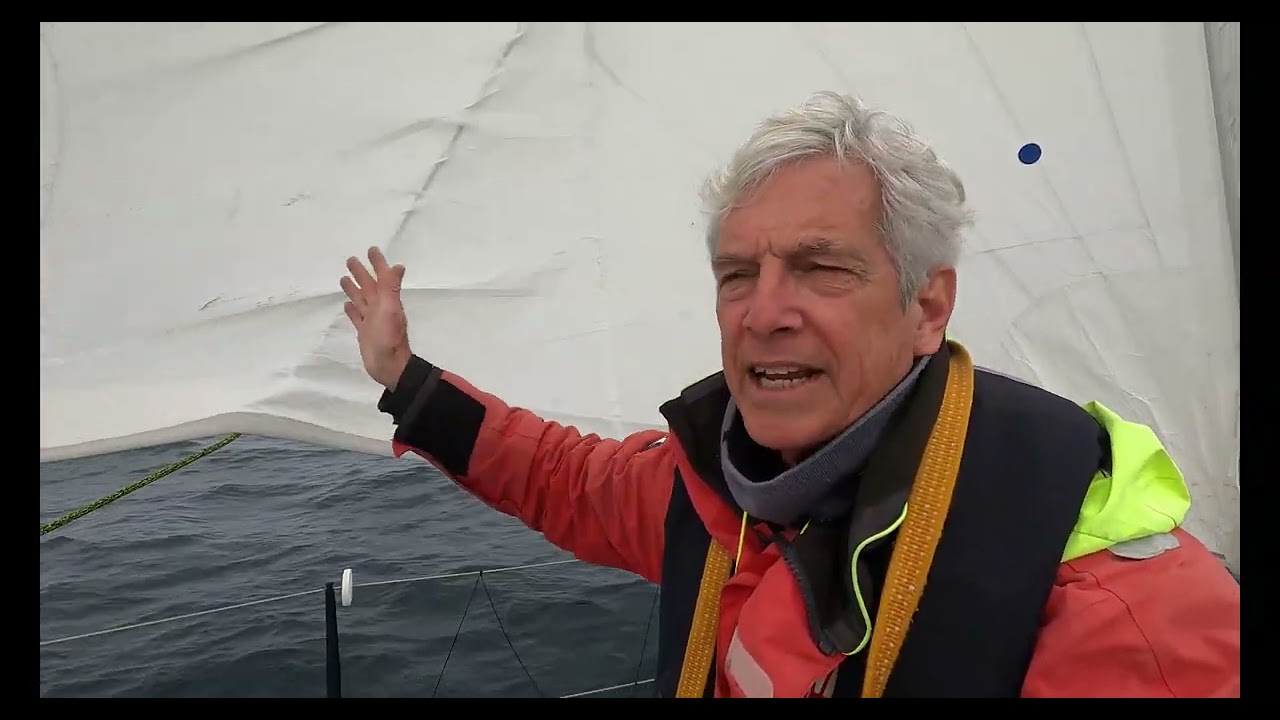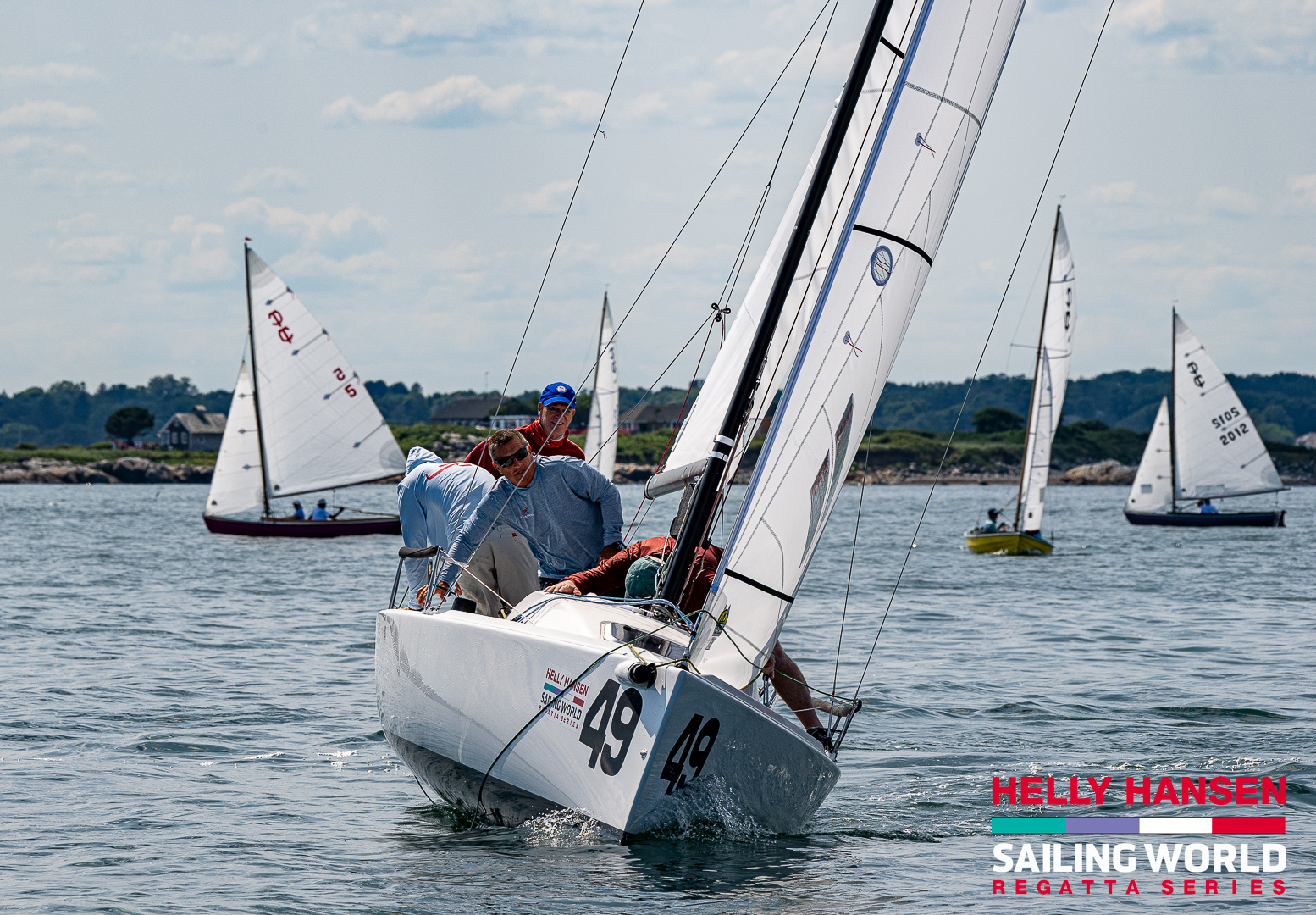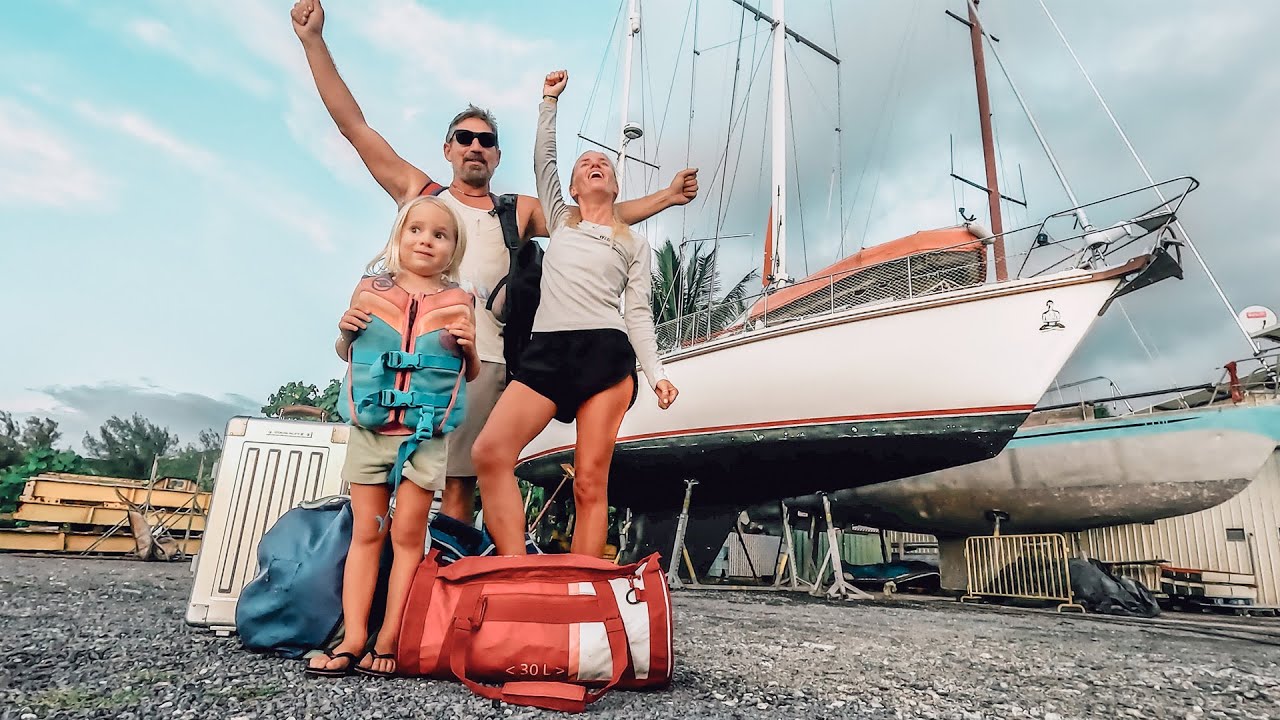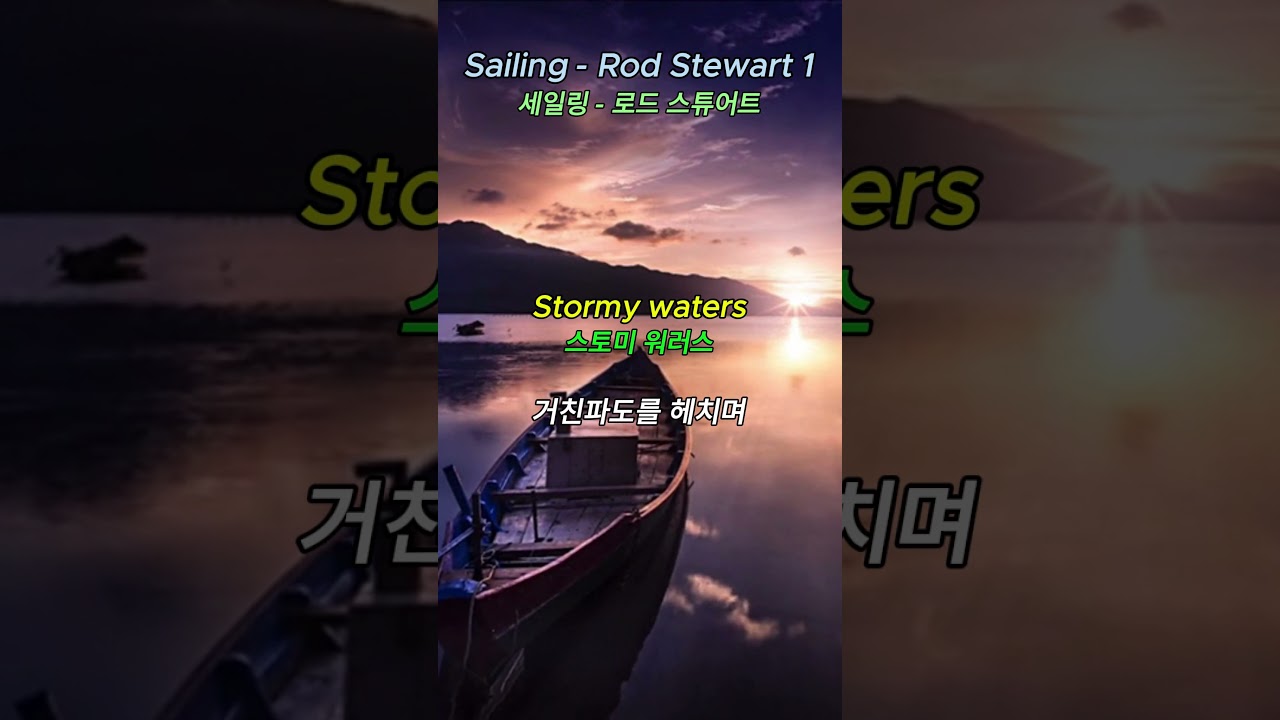Plec din Dingle Ireland spre coasta de sud a Islandei, un pasaj de 830 nm. Cheltuiesc prea mult explicând noua mea jucărie: un înfășurator de sus în jos, dar apoi sunt răsplătit de condiții aproape de vijelie timp de 3 zile. Multa distractie. Amintiți-vă: Alessia in Atlantis de Nathalie Laine 🙂 Ea ignoră toate regulile de muncă și mă pune pe un comision la bucată.
source
Ep 61 Navigare singur în Islanda fm Irlanda

39 thoughts on “Ep 61 Navigare singur în Islanda fm Irlanda”
Comments are closed.




Since you asked…
MY experience with top down furling an A2 spinnaker:
1. PITA as a solo sailor
2. locking the furling line will NOT keep the sail from unfurling in big wind- the continuous line does not have enough friction to keep the drum from spinning
3. when unfurling use the furling line to unfurl- OTW if you only pull on the sheet the furling drum will wrap the loose furling line around itself
4. In low to moderate wind (6-10 kts) OK to hoist with genoa furled
5. when furling – have the TWA at about 160 with the main fully out. The kite will be collapsed mostly. Run the acitve sheet once around the winch and take it with you to in front of the mast. Keep some tension on the active sheet with your hand or foot while you furl it in. Watch the foot of the sail to notice when the tack has grabbed the sail and started furling it backwards. If you see this stop and unfurl some then try again. The mid girth will only furl in unison with the top when there is enough tension at the right angle. As soon as the sheet starts to turn around the torsion line stop furling- don't put multiple wraps of sheet around the torsion line- that will only make it harder to unfurl next time. As soon as it's furled release the halyard and drop the furled kite on to the deck ( before you bring in the tack) . OTW it will start to unfurl pretty quickly.
6. Gybing- not more difficult than conventionally hoisted kite. I prefer inside gybes- I turn down to 160 TWA and let the main out. – completely release the active sheet and pull quickly on the new sheet to bring the clew around the forestay . Once on the new side I head up to 140 TWA and adjust as needed. No worry of lines under the boat- the sprit prevents that. Outside gybing is also possible provided you have a short batten attached to the luff to catch the sheet. Timing is critical though- the gybe has to be initially fast after releasing the active sheet so the sail flies out in front then slow through the turn to have time to bring in the new sheet before the sail fills.
Given all this as I stated previously I have gone back to no furlers on my A2 or A5 but bottom up continuous line furlers on my staysail and Code 0. The fixes for problems with conventionally hoisted A2 are easier than the fixes for partially or improperly furled kites with top down furler. I think some sailmakers are now offering specially cut gennakers which address some of the issues with top down furlers.
another tip- tie a snatch block to the end of the continuous furling line with a bungee and fix so that there is always tension on the furling line
Patrick you are a straight BOSS. God bless you and keep rocking brother
Always inspiring, Patrick!
Great video & channel Patrick, appreciate the proper sailing like CW and SWT instead of tits and drama…
hi patrick. thank you for your great videos.
if you kindly answer question. how do you deal with the boat insurance issue single handed to this places?
Another fantastic vlog and safe, but exciting passage! Thanks for sharing Patrick…you made me smile just as much as Team Malizia racing around the World 🙂 Fair winds and following seas
"Suffering cures all ailments, through tears or sweat, or going out to sea."
Sir Patrick Laine
Given your current sail inventory, at what point would you consider streaming warps if at all when running downwind.
Glad you know what you’re doing – this sail, that sail, inside, outside ??? OMG – my brain hurts – always love your posts – would sure like to know what you do when you’re not sailing – be safe out there and look forward to your future posts 👍👏🌹
So happy to have your videos back! Your daughter's new book is on the way to my granddaughter, it will be there money. Polly enjoyed the first one, I am sure she will like this! Sail to Florida some day you can visit Patrick Airforce Base … actually Space Force I think now.. your space coast fans can at least wave and buy you some Mad Dog 20 20!!! Lol!!
Clever and hugely experienced skipper.
Also very interested to know what you think of NKE vs Raymarine autopilot. I was very impressed with NKE on a POGO I chartered in Greece I must say.
Great vid. Love the real stuff!
Regarding top down furler: the two sheets can get a different number of turns if not properly stored in the sail bag. What happens is that the head or tack inadvertently is allowed to go through a sheet thus adding or removing a wrap. Solution is simple: use a soft shackle to attach the sheets just prior to hoisting. I use 2 soft shackles, one on each sheet, but a single for both does work. Store the sheets in the sailbag if you want, but not attached. And restringing a single sheet while underway is a PITA. I suspect you will find two are easier to manage. When I race shorthanded, I always put the jib out. This prevents the spinnaker from wrapping around and getting tangled in the headstay. A top down furler only works on spinnakers without big shoulders. An A2 has a midgirth that is sometimes greater than the sail's foot length and therefore won't furl cleanly. An A3 can work as does the code 0, both of which should have midgirths at about 75% of the foot. I do both inside and outside gybes. For outside, just release the sheet and let it fly like a flag, turn the boat and when on the new heading, haul in on the other side. Inside gybes are easier if the jib is partially deployed (to prevent the aformentioned headstay wrap).
Overall, a top down furler is a game changer when shorthanded sailing – once everthing is figured out on how to work with it, I suspect you will never want to go back to a sock.
Keep those videos coming. You are an inspiration!
Bikini??? Patrick listen, no one of a sound mind would want to see you in a bikini. 😁
I suppose, like for like, a long keel/full feel would be a bit more confortable than a fin in heavy seas (though they are usually relatively narrow in the beam. Perhaps a full keel would actually pitch more than a relatively flat-bottomed fin? Against this, there is something like the Miura 30, which is fin-keeled, which I believe rather comfortable in heavy seas and apparently very popular for long ocean crossings. A great success from the Cape of Storms.
The Miura's extreme tumblehome gives it a potbellied look. I wonder whether tumblehome adds to comfort in rough weather? I often sense gasps of admiration from all and sundry when someone mentions tumblehome in a comment and I wonder what their benefit is and why so few designs include a tumblehome.
I am always intrigued by the notion of bluewater cruising in a bilge-keeled boat. Seems like a silly thing to do (poor pointing to wind, leeward drift, etc.) yet there is plenty of evidence of success and I think of Chay Blyth's favourable comments about feeling very safe in his Kingfisher 32 in the South Atlantic. (Though, granted, he didn't complete the RtW.)
Children are often more sensible than grownups when it comes to "recommended ages" (something publishers invented). I would venture to suggest that Nathalie's storytelling would be enjoyed outside that range, right up to grownup children.
Why are hammocks so llittle used, effectively a bed-on-gimbles? Has anyone ever designed or rather constructed a cruiser where the entire below-decks is on gimbles? The only tricky bit would be the companionway entrance, but then that often is tricky in any case. I suppose the big trade-off would be a loss of the sentiment du fer that you get through your body propped in a wildly moving confine.
What model of boat are you sailing ?
Other than the (granted, enormous) advantage of complete control from the safety of the cockpit with roller-furling of foresails, it seems that in every other aspect, hank-on is preferable: trim and performance, simplicity, maintenance…). There seem to be plenty of adherents of hank-on even among the solo sailors. This makes me wonder whether there are other / better ways of managing foresails from the cockpit, but using hank-ons. My idea is running the halyards (hoist and drop) down below-decks along the cabin ceiling to the cockpit. More purchase and power than normal deck route to cockpit? Perhaps even less friction?
No need for the "Sorry gents"…(context 'no bikinis').
No bikinis = good. I prefer to watch real sailing, thanks.
All the best from Perth, Western Australia.
Arvind
Great video, as always, Patrick. Congratulations on yet another successful passage. I sailed to Iceland from Northern Ireland in1967 in a Vertue and although almost everything else has changed, the north Atlantic ocean and the weather remain the same.🙂
After a long wait, thank you for showing us real skills and a different perspective on sailing.
On the setup of the asymmetric, I was surprised to see your starboard sheet to be inside the Genoa and not running outside the Genoa luff. I'm curious to know how you would have gybed under such conditions.. I'm running everything outside the boat and when sailing solo, it is not always obvious to rig it right before hoisting…
Looking forward with great appetite for the next leg.
Fair winds till then !!
Ssssooooooo glad your back. Still praying for you.
Your channel is so informative..
BZ , Skipper, Wow! No dilly-dallying, here she is, new vessel on a shakedowns cruise to ICELAND!! Thank you again for sharing this new adventure! Fair Winds
Really enjoyable video yet again Patrick, thanks for sharing. I wonder if you could include a little detail about the software you use for navigation and route planning and the hardware. Are the charts downloaded in advance? How do you download the weather data when you are offshore?
I'm looking forward to your next video, Greenland?
Patrick – I'm mostly a white sails guy, but there is a series on Yachting World's youtube where Pip Hare demos many sail-handling techniques (albeit doublehanded). Here is the link to one on furling sails… https://youtu.be/JCAddFglf6g
A brisk and lively sail! Glad to see that you found your weather window Patrick, that you've arrived safely, and that you're continuing to share online. Looks like your autopilot managed just fine as you were roaring along. Will be very interested to see what refinements/choice you make as you gain efficiency managing the RM. Fair winds, stay safe. Regards, Dave Syer.
I enjoyed your sail in the North Atlantic. Looking forward to the next one. I'm glad to be a phantom shipmate.
looking forward to the next eposode!
Most pleased that I came to mind before super-tough guy Erik Aanderaa … Ruth Avery is 31' on deck, btw. Holy cow, Iceland! I'm impressed. You've done a lot of really hard sailing since I've followed you on YouTube. You are from that older, tougher generation, apparently. I just turned back to Beaufort because the weather maps were showing 25-35 knots off Hatteras.
Polar Patrick …cool as an ice cube in a container of liquid nitrogen….after flying fighter jets for the navy really no surprise 😂
Patrick watching your videos is always light, inspiring, rich and sooo cool. Merci, vraiment merci for sharing these with us. God bless
I just wonder, how do your daughters rest easy watching your videos. My heart is in my mouth at times . They have my sympathy. I suppose writing books helps.😮
Thank God you're not going to wear a bikini!
I prefer the Bangles' to S&G's version.
You're loved and being allowed to go sailing.
That's all the commission you need.
Nice technique Pat! Good storytelling as always!
I’ve been away last week 😉 but ended up in not buying that boat. Now I have my focus on another one ⛵️
Patrick Ep 60 and Ep 61 are your best to date in my humble opinion. La Rochelle to Ireland in one hit is a hell of an undertaking with all the traffic and lack of rest. I would have to break that one up into manageable passages. I don't think I've ever been far so soon after buying a new boat. Again … not an easy thing to do. Talking about ideal lengths for the open ocean, Joshua Slocum decided that 38 feet was about right for the ocean. Close friends of mine who have circumnavigated the thick end of twice, did so first in a 30 foot boat. With that experience they decided on a 41 foot Koopmans 41. You would be hard pressed to find something better for making very long voyages. But she's just a tad bit hard work for us solo sailors. We need to remind folk that when the weather gets really severe the sea will toss anything about. Provided you're a cork you stand a chance. And again a reminder … folk just can't think they can buy a boat and set off. It takes a lot of miles to become part of a good crew and a lot of miles and work to understand what is required to sail alone. It is no more skilled than being part of a crew but it is a completely different discipline. And it works for very few. So folks, don't be lured just because Patrick makes it look easy. Fair winds and stay safe. James
Just the best! Love the measuring scale for waves! Very true
My wife and 11 year old son read "Alessia in Atlantis" together as a daily ritual before going to sleep – they loved it! Full of imagination, twists and turns! They'll be happy to hear the sequel has arrived 🙂